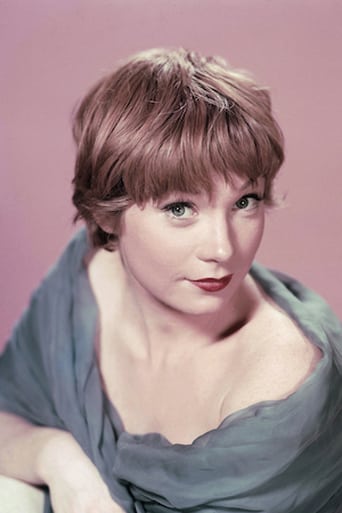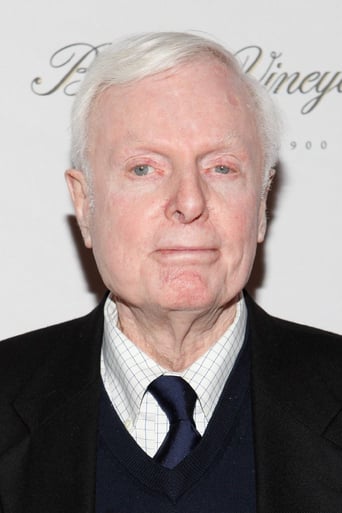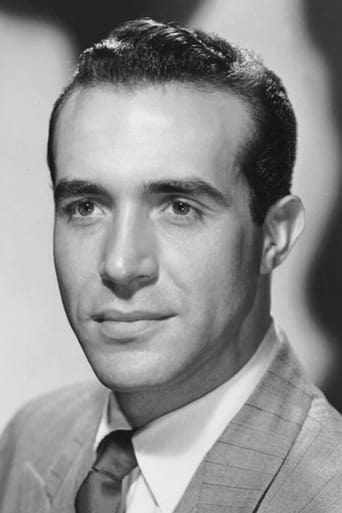NekoHomey
Purely Joyful Movie!
Erica Derrick
By the time the dramatic fireworks start popping off, each one feels earned.
Mandeep Tyson
The acting in this movie is really good.
Dana
An old-fashioned movie made with new-fashioned finesse.
HotToastyRag
In Sweet Charity, Shirley MacLaine plays Charity, the original hooker with a heart of gold. Well, that's not entirely true; Sweet Charity is a remake of the Italian film The Nights of Cabiria, which won the Oscar for Best Foreign Film of 1957. In any case, the hooker with a heart of gold archetype is embodied by the protagonist in this story.While the Italian film is depressing beyond belief—Don't get me wrong, I absolutely love the movie and have seen it many times—the musical is slightly different. There are many dramatic, depressing musicals, and this isn't one of them. It's fun and colorful with uplifting songs, a lighter title, and a generally sunny disposition. I won't spoil anything, but if you're looking for a downer, try Oliver instead.Shirley MacLaine is darling! I know, it seems like I'm always talking about how cute she is, but she is particularly adorable and charming as Charity. Shirley got her start as a dancer, and in this movie, she's able to really show off her skills (and her legs). It's a Bob Fosse musical, so if you've never seen his choreography before, prepare yourself for a very different type of dancing. Dancers will stand perfectly still for several beats, breaking the stillness by a single shoulder shrug or finger flick. It's a very controlled, intense, stylized kind of dancing, one that uses a Hollywood camera to its advantage. The dance numbers are beautifully directed and framed in each shot. Usually, you'll either love Bob Fosse or hate him, so it might be a determining factor in your enjoyment of the film.It's difficult to pull off the heart of gold hooker role convincingly. In my opinion, Giulietta Masina conveys the "seedy hooker" aspect of the character a little better in the original version, but it's also a darker, sadder film, so that makes sense. In Sweet Charity, Shirley MacLaine chews gum and sports a heart tattoo on her shoulder, but that's about it. Still, she nails the hopeful, utter faith in human nature aspect, which delights audiences and draws them into her story.When I first watched the movie, I wasn't really too impressed with the songs. Now that I'm older and have written three musicals myself, I actually like Cy Coleman's and Dorothy Fields' creations better. For me, part of what makes an effective musical song is if the melody conveys the words of the song, even if the words are hidden. In "Big Spender", the famous song all the streetwalkers sing to a potential customer, the melody captures the boredom they feel, as well as the frustration simmering underneath. You can really feel it's a song that's been sung a hundred times a night. In "If They Could See Me Now", another famous song that Shirley MacLaine sings with a top hat and cane, it actually sounds like it's being sung on her tiptoes, while she's excited and afraid if she shouts it'll echo off the walls. And finally, one of my favorites, "There's Gotta be Something Better Than This": you can truly feel the frustration boiling over as the girls finally declare they've had enough of their terrible lives. To see what I mean, watch the YouTube clip of the song, and if you like it, rent the movie!
Robert J. Maxwell
It's too bad Bob Fosse came to prominence so close to the end of the musical era, or the Golden Era, or whatever it was. There would be musicals to come, but nothing resembling, say, 1945 through 1959.Fosse had a unique style. It owed nothing to ballroom dancing, like Fred Astaire's; it wasn't athletic like Gene Kelly's; not as balletic as Jerome Robbins; and it wasn't as acrobatic as Michael Kidd's; but, at its best, it was at least as thrilling as the best of his forerunners'. Fosse had people striking awkwardly appealing postures, knock-kneed and pigeon-toed, with their rumps thrust out and a derby on their heads. Sometimes, with the non-dancers in "Cabaret", the style became minimalist, with the actors sidling along the stage, waving the fingers on their dangling arms, all of it helped enormously by innovative orchestral arrangements, full of clicks, clunks, and booms.Fosse himself was a splendid dancer. His number in "Kiss Me Kate," with Bobby Van and Tommy Rall, raises the hair on the back of the viewer's neck. Even in sluggish material like "My Sister Eileen", he stands out in a competitive dance with Tommy Rall. You know the "airplane" steps that Gene Kelly does for the French kids in "An American in Paris", whirling around like an airplane propeller? Fosse does it here, but at a blistering speed. He seems barely to touch the ground.There's a lot of posturing in "Sweet Charity" but not much verve elsewhere. The most kinetic number is probably "There's Gotta Be Something Better Than This," with Shirley MacLaine, Chita Rivera, and Paula Kelly on a rooftop.Alas, the movie isn't as good as it could have been. The score might be accommodating two or three symphony orchestras, given what it sound like, but the tunes themselves aren't really memorable, despite our having heard at least two of them -- "Hey, Big Spender" and "If They Could See Me Now" -- over and over in the media. The second sounds like the kind of loud, peppy show-stopper that seems de rigueur for all Broadway musicals -- "Tomorrow","You're Gonna Hear From Me", "Everything's Coming Up Roses," "The Impossible Dream," and "I'm Dead But Still Smiling." Well -- not that last one. I made that up, but you get the picture.Some have complained that the story is depressing -- and it is. Sad musicals aren't all that rare. "It's Always Fair Weather" was sad in addition to being a vehicle for dull tunes, and in Fosse's own "All That Jazz", the central figure checks out with a heart attack (as Fosse himself was to do; I hope Fosse found the Angel of Death to resemble Jessica Lange in white lace.) The lyrics are better than the tunes themselves. There's considerable wit in some of them. Sammy Davis, Jr., as a hippie priest gets to tell us never to smoke "marijuana, grass, reefer" because it's "sinful, wrong -- and EXPENSIVE." MacLaine is not dumb but she's gullible as hell. Fellini's original was a tragedy. But Fellini's earned its tears because it was so well done. This story doesn't measure up and MacLaine might just as well have run off to "New Jersey or someplace" and lived happily ever after.
SnoopyStyle
Taxi dancer Charity Hope Valentine (Shirley MacLaine) tries to have hope despite being pushed into a lake by her boyfriend Charlie. She meets the Italian movie star Vittorio Vitale (Ricardo Montalban) but his volatile statuette girlfriend returns. Then she's stuck in an elevator with flustered Oscar Lindquist (John McMartin). She tries to keep her real life a secret from him.Shirley MacLaine is great and there are a couple of terrific songs like 'Big Spender' and 'If They Could See Me Now'. She is a really funny broad. This is Bob Fosse's movie directorial debut. He shows that he can stage performances. The pacing does drag a little here and there. MacLaine is always there to pick up the movie when that happens. There is an alternate happy ending filmed. The movie works either way and its fun to see both.
Galina
My love and admiration for Federico Fellini/Guiletta Masina's film Nights of Cabiria had stopped me for long time from seeing Sweet Charity, the adaptation of the musical based on the same story which was made into a highly successful Broadway show directed and choreographed by a multi talented Bob Fosse. I am a fan of Bob Fosse. I love all his films, musicals and not, but I was hesitant to see Sweet Charity the movie and I never had a chance to see the Broadway musical. Well, I finally did and I can say that nothing is wrong with transporting the same story to the different time, place, language, medium, and to use the different artistic tools. The story is the same; the films are as different as Rome and NYC or as Federico Fellini and Bob Fosse. Fosse's film should be judged on its own terms, and it has a lot of breathtaking scenes to enjoy, bright colors, outrageously stunning costumes (the work of incredible Edith Head), adorable and unbelievably cute Shirley MacLaine, Sweet Charity Hope Valentine, and the best of all - the dancing sequences to die for. Among them, splendid The Big Spender is perfection and the real treasure. Fosse's staging of the musical numbers is outstanding. The most memorable moment in the movie for me was stolen from Shirley MacLaine by Chita Rivera in Big Spender. Just watch Rivera's seemingly boneless arms, the right one around her head and the left one behind her back, the left hand on her right hip as she sings, "do you want to have fun, fun, fun?" For this moment alone, I like the film even if I see very well that it has some minuses, too. The first act between two intermissions was really good, and it includes the best dancing and singing numbers: "Hey, Big Spender", "The Pompeii Club", "Rich Man's Frug", and "If They Could See Me Now". After the second intermission the movie went over the hill. I believe that it could do without both intermissions. We are not watching the show at the theater, and the intermissions only took time. The "hippiest" "Rhythm of Life" scene was overlong, did not make much sense, and made me want to fast-forward it. I take it that Fosse wanted to experience with the camera movements and different techniques in his very first feature film which was a screen transfer of his Broadway Musical. This is the only explanation of his multiple slow-motions, stills, color/black/white and back changes that did not add anything to the film, just paused it with no apparent reasons. His next screen adaptation was timeless Cabaret, and he had improved his directing style dramatically. As the result, Cabaret has stayed his greatest achievement along with All That Jazz.Coming back to the original tragic comedy "Nights of Cabiria", of all the characters Fellini had given life on screen, by his own words, Cabiria was the only one he worried about many years after the film was made. Of all the characters, I've seen in films, Cabiria is the one I often think about - whatever happened to her? Did she survive? Was she able to find love? As much as I like Shirley MacLaine/Charity, I did not worry about her future. She lived happily ever after - in both movie endings, theatrical and alternative.







